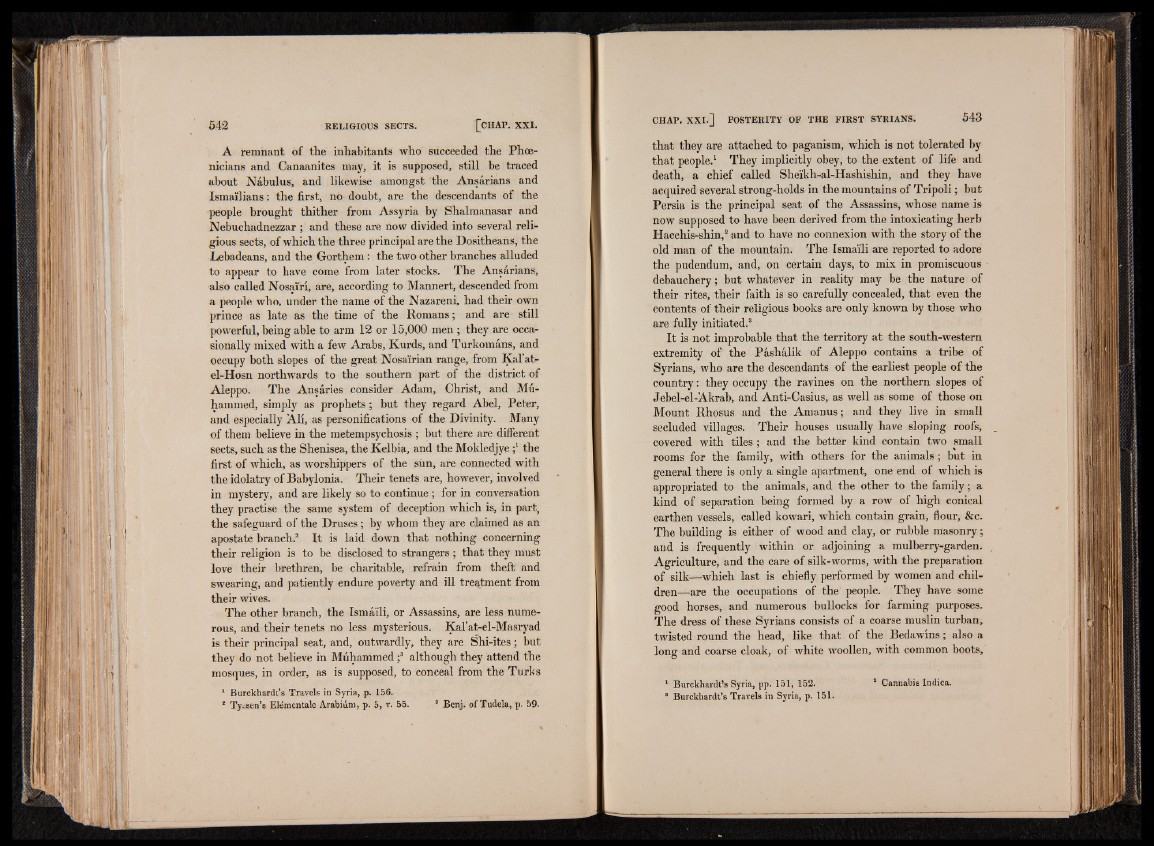
A remnant of the inhabitants who succeeded the Phoenicians
and Canaanites may, it is supposed, still be traced
about Nabulus, and likewise amongst the Ansarians and
Ismailians: the first, no doubt, are the descendants of the
people brought thither from Assyria by Shalmanasar and
Nebuchadnezzar ; and these are now divided into several religious
sects, of which the three principal are the Dositheans, the
Lebadeans, and the Gorthem : the two other branches alluded
to appear to have come from later stocks. The Ansarians,
also called Nosa'iri, are, according to Mannert, descended from
a people who, under the name of the Nazareni, had their own
prince as late as the time of the Romans; and are- still
powerful, being able to arm 12 or 15,000 men ; they are occasionally
mixed with a few Arabs, Kurds, and Turkomans, and
occupy both slopes of the great Nosairian range, from Kal’at-
el-Hosn northwards to the southern part of the district of
Aleppo. The Ansaries consider Adam, Christ, and Mu-
hammed, simply as prophets; but they regard Abel, Peter,
and especially Ali, as personifications of the Divinity. Many
of them believe in the metempsychosis ; but there are different
sects, such as the Shenisea, the Kelbia, and the Mokledjyethe
first of which, as worshippers of the sun, are connected with
the idolatry of Babylonia. Their tenets are, however, involved
in mystery, and are likely so to continue ; for in conversation
they practise the same system of deception which is, in part,
the safeguard of the Druses; by whom they are claimed as an
apostate branch.2 It is laid down that nothing concerning
their religion is to be disclosed to strangers ; that they must
love their brethren, be charitable, refrain from theft and
swearing, and patiently endure poverty and ill treatment from
their wives.
The other branch, the Ismaili, or Assassins, are less numerous,
and their tenets no less mysterious. Kal’at-el-Masryad
is their principal seat, and, outwardly, they are Shi-ites; but
they do not believe in Muhammed ;3 although they attend the
mosques, in order, as is supposed, to conceal from the Turks
1 Burckhardt’s Travels in Syria, p. 156.
* Ty.isen’s Elemcntale Arabiiim, p. 5, v. 55. 8 Benj. of Tudela, p. 59.
that they are attached to paganism, which is not tolerated by
that people.1 They implicitly obey, to the extent of life and
death, a chief called She'ikh-al-Hashishin, and they have
acquired several strong-holds in the mountains of Tripoli; but
Persia is the principal seat of the Assassins, whose name is
now supposed to have been derived from the intoxicating herb
Hacchis-shin,2 and to have no connexion with the story of the
old man of the mountain. The Ismaili are reported to adore
the pudendum, and, on certain days, to mix in promiscuous
debauchery; but whatever in reality may be the nature of
their rites, their faith is so carefully concealed, that even the
contents of their religious books are only known by those who
are fully initiated.3
It is not improbable that the territory at the south-western
extremity of the Páshálik of Aleppo contains a tribe of
Syrians, who are the descendants of the earliest people of the
country: they occupy the ravines on the northern slopes of
Jebel-el-Akrab, and Anti-Casius, as well as some of those on
Mount Rhosus and the Amanus; and they live in small
secluded villages. Their houses usually have sloping roofs,
covered with tiles ; and the better kind contain two small
rooms for the family, with others for the animals; but in
general there is only a single apartment, one end of which is
appropriated to the animals, and the other to the family; a
kind of separation being formed by a row of high conical
earthen vessels, called kowari, which contain grain, flour, &c.
The building is either of wood and clay, or rubble masonry;
and is frequently within or adjoining a mulberry-garden.
Agriculture, and the care of silk-worms, with the preparation
of silk—which last is chiefly performed by women and children—
are the occupations of the' people. They have some
good horses, and numerous bullocks for farming purposes.
The dress of these Syrians consists of a coarse muslin turban,
twisted round the head, like that of the Bedawins; also a
long and coarse cloak, of white woollen, with common boots,
1 Burckhardt’s Syria, pp. 151, 152. 2 Cannabis Indica.
8 Burckhardt’s Travels in Syria, p. 151.